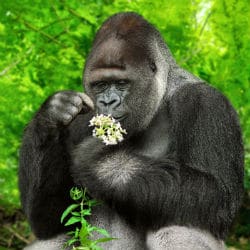Wild Mountain Gorilla Population On The Rise

There is some good news coming out of the mountains of Virunga National Park in the Democratic Republic of Congo. The population of gorillas rose from 480 in 2010 to 604 in 2016. When you add that population to the couple hundred other apes that live in scattered habitats to the south, it is estimated that more than 1,000 mountain gorillas live in the wild, making it the only subspecies of the great ape that is rising in number. Whilst 1,000 may seem a small number one should remember the International Union for Conservation of Nature classifies the mountain gorillas as critically endangered.
The outlook used to be extremely grim
Poaching and habitat destruction still represent major threats to the species but in order to understand what the figure means one would need to go back in time by about fifty years. In the 1960’s the mountain gorilla population was in complete free fall. Livestock shepherds were driving their herds into gorilla habitat and humans were razing the forest for agriculture and charcoal as well as setting traps that would doom not only the prey they hunted but any great ape that had the misfortune of becoming snagged in one. Add to all of that poachers targeting gorillas for their meat or for trophies and even as exotic pets. By 1981 there were only 242 mountain gorillas left in the wild and it was expected the subspecies would be extinct by the millennium.
A lot of personal sacrifice to save the species
A lot of people have made a great number of sacrifices to protect the species over the last two decades. Over 170 rangers have lost their lives and as recently as April five rangers were shot and killed in Virunga National Park by local militia. The charcoal industry continues to be a threat as are home made wire snares. These threats are the product of a local community who lack economic opportunity and rely on natural resources that are abundant in the national parks. This means it is important to include locals in the conservation efforts.
Co-opting the local community to help with conservation
As a result, conservationists are seeking to provide improved access to food, water and security for these people as well as provide education and job training. About 10 per cent of the of the park’s entry fee is used to fund initiatives that improve the lives of local communities so they understand that they directly benefit from the gorillas. The perseverance of the species may inspire greater conservation because it is an example of the difference people can make even when the outlook is grim.



